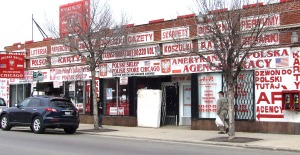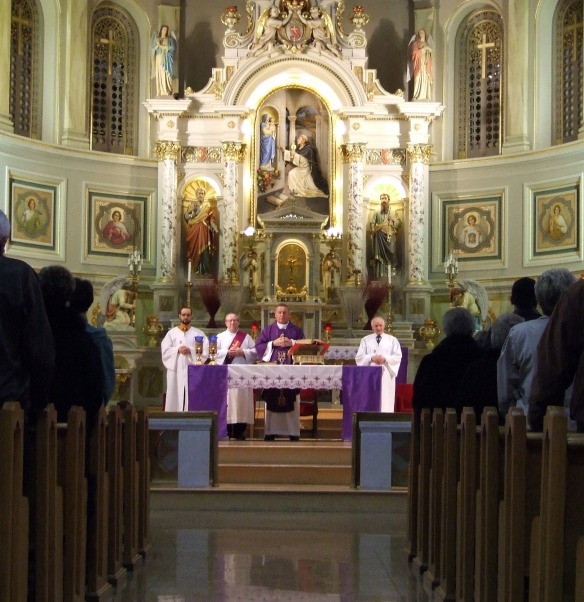By Ewa Lyczewska
“It breaks my heart. I treat Avondale like my home, this is my home,” says Stasia Jozwik, a 58-year-old owner of Szarotka, a florist shop in Avondale, who moved to Chicago from Poland 25 years ago but now lives in Niles.
According to Northwest Chicago Historical Society’s records, Poles begin to move into Avondale neighborhood in 1890s. Avondale lies west of the North Branch of the Chicago River between Addison Street on the north and Diversey Avenue on the south, stretching westward to the tracks of the Soo Line Railroad. The Polish Avondale flourished in 1980s as the martial law in Poland brought a flood of immigrants. “If you were to come on Sunday to Avondale 30 years ago, you would think you were on Marszalkowska Street [one of the main streets in Warsaw],” says Jozwik,”That ended in 2000.” As Poles are moving away from Avondale, Polish businesses are struggling and closing their doors, and the neighborhood is loosing its Polish identity.

Polski sklep (Polish store), located on 3067 N. Milwaukee Ave., Chicago, is one of the few last Polish businesses in the area. Photo by Ewa Lyczewska.
Jozwik is just one of the many Polish business owners fighting for survival. “Everything is closing down. There used to be four Polish restaurants in this area, now there is only one,” says Ralph Pietrzyk, 65, from Mount Prospect, who works at Apteka Ziolowa, a drug store, in Avondale. “I am thinking of closing my store next year,” admits Elizabeth Krupa, 62, an owner of Eva, a Polish bookstore, who lives in Prospect Heights. “I have one customer a day, not enough to make a rent,” says Jozwik. “In the past, I had three people behind the counter and there would be 15 customers in store at one time, now it is only me and two customers a day,” says Krystyna Henia, a 58-year-old owner of Back to Nature store, who lives in Northbrook.
But not only Polish stores are struggling. Krzysiek Grot, 29, Chicago, an owner of Café Lura admits that the business is not as it used to be. The bar, which took its name after a strong and black coffee, was opened in 1986 by his parents who wanted a meet-up place for Polish artists living in Chicago. Only 10 years ago, the place was full with people, open seven days a week and serving food, says Grot. Today, the bar is open Friday through Sunday, the place often rented on weekends for events attended by Americans and Hispanics. “I might sell the place some day,” admits Grot, “but I do have a sentiment for it.”
“There are no Polish people living in the neighborhood and the ones that are still here are an old generation that decided to stay because of St. Hyacinth Basilica, says Jozwik.“ Sister Aleksandra Antonik, 29, who works and lives in St. Hyacinth Basilica parish, admits, “We do not have families with children in the neighborhood. The benches during the mass are becoming emptier.” Henia had to get rid of the merchandize for children at her store, as no one was buying it.

The church used to be so full on Sundays that you had to stand during the mass. Today there is plenty of space and mostly old people come for the mass,” says Stasia Jozwik. St. Hyacinth Basilica is located at 3636 W. Wolfram St. in Chicago and offers four Polish masses on Sundays and two during the weekdays. Photo by Ewa Lyczewska.
“We used to have over 500 students, now we have about 300,” says Jadwiga Pytlik, 59, from Niles who is a vice-president and a Polish literature and history teacher at Stefan Cardinal Wyszynski Polish School at St. Hyacinth Basilica that is open on Saturdays. “In older days, our students were immigrants from Poland, today, our students are born in the U.S,” says Pytlik. Although some children come from other Chicago neighborhoods, most of them come from suburbs, says Pytlik.
Some Avondale Poles moved to the suburbs, says Pietrzyk, some moved to Colorado and Arizona, adds Krupa. “A lot of people who lived in Avondale were illegal, when the recession started here, and Poland began to do better [economically] and then became part of the European Union, they [Poles living in Avondale] moved to Europe. No one new is coming. They can find work at home.”

Freshmen Klaudia Marzec (left), 14, Elmwood Park, and Jennifer Wardach (right), 15, Chicago, are taking a quiz about the Renaissance Poland. The school meets every Saturday from 9 a.m. until 12:30 p.m. Photo by Ewa Lyczewska.
“I was trying to rent out my apartment few months ago; most of the people who came to see it were Hispanic.” According to State of Illinois statistics, Avondale’s Hispanic population grew from 38 percent in 1990 to 62 percent in 2000. Probably soon, only the sign over Milwaukee Avenue, “The Honorary Polish Village” will be a solitary indication that Avondale was once Polish.
